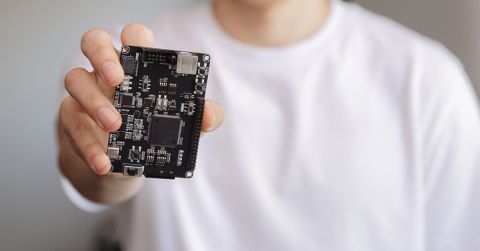CCD Signal Processor ICs for Precision Imaging

Smartphones almost universally use CMOS sensors, but there are plenty of applications that rely on CCD sensors. High-resolution still cameras, time-of-flight imaging, CCTV video cameras, and many precision imaging or measurement applications make use of a CCD sensor and require an IC for signal processing. CCD signal processor chipsets run at a range of speeds and bit depths, providing a range of color depth and frame rates for a variety of applications.
The great aspect of these chipsets is they integrate the important signal processing components into a single package, rather than forcing a designer to build them manually from discrete components. This allows specialized imaging systems to be placed on smaller boards and in smaller packages. Here’s what to look for in your next CCD signal processor IC and some options for a range of applications.
Why Use a CCD Signal Processor?
Before we entered the realm of highly integrated CCD arrays with integrated image processing capabilities, most functions had to be built out with discrete linear components, e.g., op-amps, analog switches, and ADCs/DACs. Just as we’ve seen with common signal chains in other applications, signal processing chains for CCDs have followed the familiar trend of integration into single packages with small footprint.
A CCD signal processor IC handles all signal-processing steps required from collecting the charge output from a CCD column to digital output with an ADC. There are some important signal conditioning steps that must be performed by the analog front end before data conversion. The important step in the analog front end is correlated double sampling (CDS). This involves calculating the difference between the reference and data levels of the CCD signal, which eliminates some deterministic noise in the CCD signal. This difference is then translated into a grey level and/or color depth in a display unit.
This important measurement function and other image correction functions are integrated into standard CCD signal processor ICs. The standard image correction steps required in CCD data conversion are DC restoration (clamping), gain and offset correction, and A/D conversion. Using a CCD signal processor IC eliminates the need to manually program these functions into a processor as they are defined at the firmware level.
CCD Signal Processor Specifications to Consider
Navigating the range of CCD signal processor specifications can be a bit daunting at first glance, but these specifications will determine how fast and accurately the system can acquire data from the CCD. Here are some important specifications to understand in your datasheet:
- Sampling rate: This is one of the most important specifications as this will determine the image acquisition rate. For video systems, this will determine the frame rate. Video applications that require high resolution without huge frame rates still require a high sample rate to acquire images with reasonable frame rate. This is normally specified in MSPS or MHz.
- Number of channels: Recall that CCDs are read out in columns, and the number of channels refers to the number of columns that can be read in parallel. This allows the basic frame rate to be multiplied by the number of channels.
- Frame rate: This is actually not specified in a datasheet, although it can be determined using the number of pixels in the CCD array, number of channels, and sampling rate.
- Output interface: These interfaces refer to how data can be read into and out of the CCD signal processor. One common output is via LVDS, while newer camera systems will output data via MIPI.
- Bit depth: This will determine the grey level or color depth in the acquired image. Common bit depths are 10-bit, 12-bit, and 16-bit.
- Form factor: This is always an important consideration, but it is particularly important for smaller imaging systems. Even larger camera systems will have some space limits, and it is generally better to choose a smaller component to make room for any required optics.
- Voltage range and power consumption: These are two other important specifications for any component, but they are quite important here as they will determine the device’s lifetime when deployed in the field.
Analog Devices, AD9970BCPZ
The AD9970BCPZ signal processor from Analog Devices is a lower-end component for image processing, but it comes at low cost compared to other devices for camera systems. High resolution images can be gathered at 65 MSPS at 14-bit with LVDS output for noise suppression. This component includes an integrated variable gain amplifier with up to 42 dB gain and an integrated timing driver. Some applications include professional HDTV cameras, broadcast cameras, and precision imaging systems for industrial applications.
 Functional block diagram for the AD9970BCPZ CCD signal processor. From the AD9970BCPZ datasheet.
Functional block diagram for the AD9970BCPZ CCD signal processor. From the AD9970BCPZ datasheet.
Texas Instruments, LM98725CCMT/NOPB
The LM98725CCMT/NOPB analog front end from Texas Instruments provides 81 MSPS sample rate at 16-bits. This analog front end component is one half of a complete image processing system for gathering high resolution with high frame rate over 3 synchronous channel sampling. This can be combined with an ASIC or embedded process to form a complete image processing architecture for high-quality images and video.
 Analog front end and image processing ASIC block diagram. From the LM98725 datasheet.
Analog front end and image processing ASIC block diagram. From the LM98725 datasheet.
This device outputs data via LVDS, requires an input clock for triggering, and can be configured over an SPI interface. The device includes an integrated timing generator and PLL to trigger the sensor drivers and shift registers for reading out data from a CCD sensor. Some applications include products like currency or document scanners, both of which require some integrated computer vision functions.
Analog Devices, ADDI9036
The ADDI9036 from Analog Devices is a much higher end product for time-of-flight imaging systems. This device runs at 45 MSPS with 12-bit depth, and it includes an integrated laser diode driver for time-of-flight imaging, a 7-channel H-driver, and a 16-channel vertical driver (V-driver). The CCD horizontal shift clocks and laser diode driver outputs can be configured with ~174 ps. Just like the earlier component from Analog Devices, this component also provides integrated black level clamping and a correlated double sampler (CDS). This component outputs data via MIPI CSI-2. The ADDI9036 is currently in production, and evaluation boards are available for developing high-resolution time-of-flight imaging applications.
 Evaluation board for the ADDI9036 CCD signal processor. From the ADDI9036 product page.
Evaluation board for the ADDI9036 CCD signal processor. From the ADDI9036 product page.
Your next CCD-based imaging system will need a range of components for image processing, and a CCD signal processor is the fundamental portion of the analog front end. You can find the components shown here and many other parts for imaging systems on Octopart.
Stay up-to-date with our latest articles by signing up for our newsletter.








